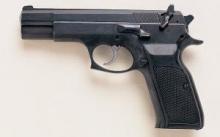Gunshot Hospitalizations Plunge Statewide

Despite grim reports of mass shootings and rising purchases of firearms in the U.S., a new report by the Office of Statewide Health Planning and Development indicates the number of patients treated at California hospitals for gunshot wounds has plummeted by more than two-thirds since the 1990s.
The report, “Trends in Firearm-Related Emergency Department Visits and Hospitalizations in California,” paints a picture that suggests outside of spasms of mass gunfire violence such as those occurred at an elementary school in Newtown, Conn. late last year and Virginia Technical University in 2007, shootings involving individuals have dramatically decreased since the early 1990s, when crime rates in California and elsewhere began a long and steep decline.
According to OSHPD, the number of shooting victims treated at California hospitals as inpatients totaled 3,575 in 2010, down from 10,832 in 1992. That's a drop of 67%. Emergency room visits for treatment of gunshot wounds also appear to be on the wane, totaling 4,755 in 2010, down 25.2% from the 6,358 reported in 2006, the most recent year for which that specific data was available.
The number of hospital days devoted to treating gunshot wound victims dropped from 68,200 in 1992 to 27,176 in 2010, a decline of 60%.
“I was very surprised,” said Mary Tran, the OSHPD research scientist who conducted the study.
However, Tran had a variety of explanations for the drop: A decline in the crack cocaine epidemic in the 1990s, combined with statistical-driven police work that led to nationwide crime rates unseen in the U.S. since the early 1960s. Community-based programs such as Cease Fire, which pressures shot gang members at hospital bedside not to retaliate, has also had an effect, according to Tran.
And unlike other parts of the nation, California has passed some strict gun control laws over the past decade, including statutes that hold gun owners criminally liable for shootings involving minors if their firearms were not properly secured.
“Peace broke out around 2000,” Tran said, when hospitalized shooting victims were less than half of what they had been in 1992. That number plateaued for a number of years before dropping again around 2006, she added.
Along with the drop in the overall hospitalization of gunshot victims, the per capita rate also slid dramatically. Hospitalizations for gunshot wounds as the result of a criminal assault dropped from 26.5 per 100,000 Californians in 1992 to 6.8 per 100,000 in 2010, a decrease of 74.4%, although rates tended to be higher in counties with large urban areas. Self-inflicted and unintentional gunshot wounds – which occur with far less frequency than from assaults – experienced similar plunges. Wounds from law enforcement interventions dropped 32.6%.
Racial demographics among gunshot wound victims have also experienced widespread changes. African-Americans are by far the ethnic group in California most likely to be hospitalized after a shooting, but their rate dropped from 126.3 hospitalizations per 100,000 in 1992 to 41.4 in 2010, a drop of nearly 70%. The Latino hospitalization rate dropped during that same period from 51.1 per 100,000 to 8.5 per 100,000, a decrease of 84%. The rates among Asian-Americans, Native Americans and whites also experienced drops well south of 60%
Meanwhile, gun sales have soared in California and nationwide for much of the last decade, driven by widely publicized mass shootings such as Newtown, along with a less dramatic spike that began in 2005, according to Tran. Background checks for gun purchases conducted by the Federal Bureau of Investigation approached a record 2.8 million December 2012, up 49% from the 1.86 million conducted in December 2011 – also a record at the time.
Tran noted that a report from the California Attorney General indicated that gun ownership has been on the rise throughout the state, although it was omitted from the final draft of the OSHPD report.
But not every indicator in the OSHPD report is upbeat. When a gunshot victim winds up being hospitalized, taxpayers are most likely to foot the bill. Medi-Cal covers treatment for shooting victims' injuries nearly 37% of the time – suggesting that shootings are still the province of lower-income people. Overall, public programs cover about two-thirds of all gunshot wound victims in California.
And costs for treating gunshot wounds at hospitals have risen dramatically, from $1,859 per hospital day in 1992 to $4,120 in 2010, far higher than the overall rate of inflation. California's hospitals also spent $112 million to treat gunshot wound victims in 2010, slightly more than in 1992 and 45% higher than in 1998, when costs had dipped to $72 million.






